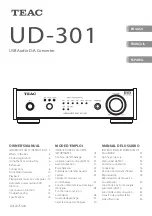
10
13. Connect the stripped, soldered (longer) end of the positive (+) cable to the red stud marked (+) on the inverter
and tighten the retaining nut.
14. Connect the stripped, soldered end of the negative (–) cable to the black stud marked (–) on the inverter and
tighten the retaining nut.
15. Connect the other (long) end of the (+) positive cable to one terminal of the heavy-duty fuse holder.
16. Connect the other conductor of the heavy-duty fuse holder to the (short) positive (+) battery terminal.
17. Connect the other end of the (–) negative cablewith the ring terminal to the negative (–) battery terminal.
18. Connect an appropriate insulated wire (refer to the “Specifications” section of this Instruction Manual) between
the chassis grounding screw on the inverter’s case and a solid electrical ground to minimize possible electrical
noise in TV and radio reception.
Do not connect this wire to the negative DC input terminal.
19. Ensure that all electrical connections have been tightened.
20. Insert the fuse into the fuse holder. There may be some sparking.
21. Ensure the 12 volt DC power source has an adequate charge.
22. Turn the inverter on and apply a test load to the 120 volt AC outlets.
* Ring terminals are not included and must be supplied by user.
If, after following all of the above steps, the inverter does not perform properly, the source voltage may be too low
or the cables may be too long (or the gauge too light). Having checked and corrected these conditions, if necessary,
refer to the “Service Information” section of this Instruction Manual for assistance if problems persist.
CAUTION
• Loose connectors may cause overheated wires and melted insulation.
• Check to make sure you have not reversed the polarity. Damage due to reversed polarity is not covered by
manufacturer’s warranty.
IMPORTANT CABLE INFORMATION:
Substantial power loss and reduced battery operating time results from inverters installed with cables that are not
able to supply full power. Symptoms of low battery power can result from cables that are either excessively long or
an insufficient gauge. Marine installations are also subjected to vibration and stresses that exceed those of other
mobile installations. Therefore, the installer/operator should be especially aware of the requirements to maintain
secure, tight, water-resistant electrical connections and to provide for strain relief for DC cables and appliance
wiring. Cable insulation must be the appropriate type for the environment.
Connecting the AC Wiring
AC connections are made on the terminal block located inside the front panel of the inverter.
To connect AC wiring:
1. Disconnect the inverter from the battery.
2. Remove the AC wiring compartment cover.
3. Feed the wires through inverter’s case.
4. Following the wiring guide located in the AC wiring compartment, connect the
L
ine (black) and
N
eutral (white
wires to the terminal block and tighten securely. The safety (green) wire is connected to the ground screw
terminal.
5. Replace the AC wiring compartment cover.




































